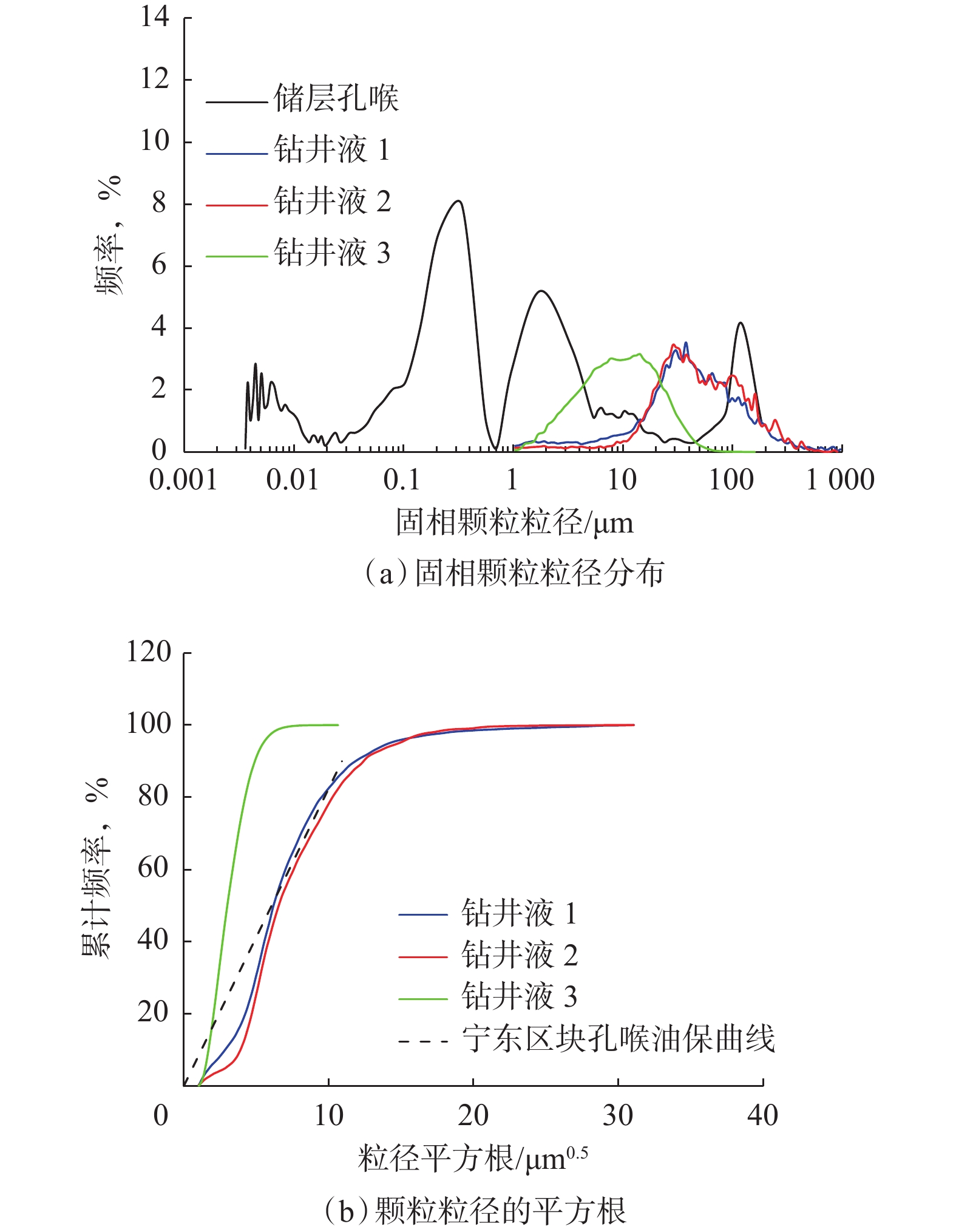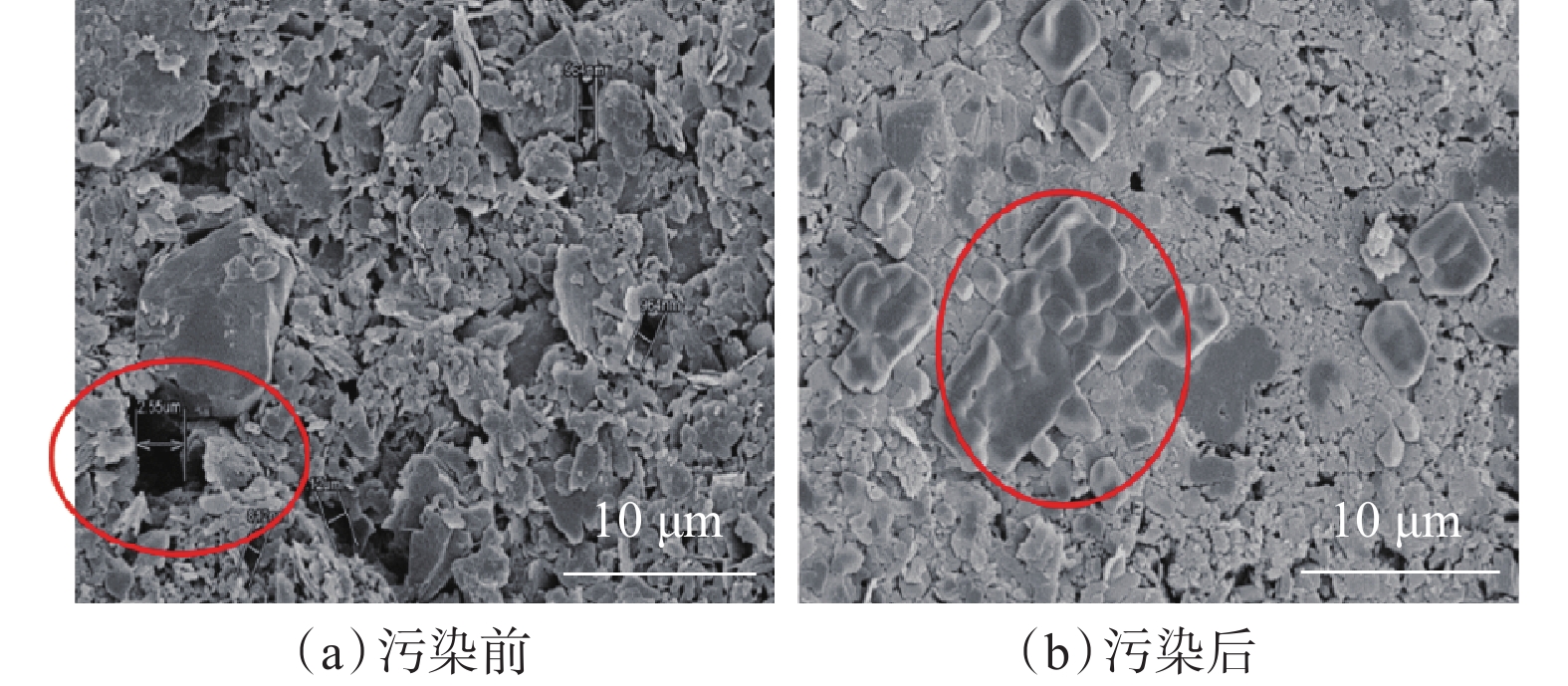Damage Mechanism and Countermeasures for Tight Oil Reservoirs in Ningdong Oilfield
-
摘要:
鄂尔多斯盆地宁东油田致密油储层岩性复杂、低孔低渗、非均质性强,钻井过程中钻井液漏失情况多发,固相、液相侵入极易造成储层损害。为明确宁东油田致密油储层的微观特征与损害机理,降低钻完井对储层的损害,进行了SEM扫描、固液伤害性测试等试验研究,证实该油田致密油储层损害的主要原因为固相侵入、水锁及伴有的水敏感性和盐敏感性;明晰了该油田致密油储层的损害机理,发现钻井所用钾铵基聚合物钻井液对致密油储层的损害较大,采用隐形酸对储层进行处理时渗透率恢复率较低。针对该油田致密油储层损害机理和钻井所用钻井液的缺点,构建了低损害无固相钻井液,其黏度为45.5 mPa·s,API滤失量为3.5 mL,对储层损害较低,渗透率恢复率达85%以上,可满足宁东致密油储层保护需求。研究结果为鄂尔多斯盆地致密油储层保护技术措施的制定提供了依据。
Abstract:Tight oil reservoirs in Ningdong Oilfield in Ordos Basin are characterized by complex lithology, low porosity and permeability, and strong heterogeneity. Drilling fluid losses occur frequently during the drilling process, and the invasion of the solid and liquid phase can easily cause damage to the formation. In order to determine the microscopic characteristics and damage mechanism of the tight oil reservoir in Ningdong Oilfield and reduce the damage to the reservoir during drilling and completion, systematic experimental studies such as scanning electron microscope (SEM) and solid-liquid damage tests were carried out. It was determined that the main causes of damage to the studied tight oil formation were solid phase invasion, water blockage, and associated water and salt sensitivity. The damage mechanism of the tight oil reservoir in this oilfield was clarified. In addition, it was found that the potassium ammonium-based polymer drilling fluid caused great damage to the tight oil formation, and the permeability recovery was low when the reservoir was treated with invisible acid. In view of the damage mechanism of tight oil reservoirs and the shortcomings of drilling fluid used in the oilfield, a low-damage and solid-free drilling fluid was constructed with a viscosity of 45.5 mPa·s, an API filtration loss of 3.5 mL, achieving a permeability recovery more than 85%, which caused low damage to the formation and could meet the requirements of protecting tight oil reservoirs in Ningdong Oilfield. The research results can provide a basis for formulating technical protection measures for tight oil reservoirs in Ordos Basin.
-
-
表 1 延5段储层敏感性评价结果
Table 1 Evaluation results of reservoir sensitivity of the Yan 5 section
敏感性
类型最大渗透率
变化率,%临界值 损害程度 水 55.00 临界矿化度下限20 g/L 中等偏强 盐 51.72 临界矿化度上限100 g/L 中等偏强 流速 44.29 临界流速0.5 mL/min 中等偏弱 碱 20.07 临界pH值11.5 弱 应力 20.80 临界应力17.0 MPa 弱 表 2 储层液相损害
Table 2 Liquid phase damage of the reservoir
岩样编号 岩样井深/m 测试流体 气体渗透率/
mD液体渗透率/
mD渗透率降低率,
%ND26-1 2 060.84 8%标准盐水 14.35 1.71 88.10 ND26-2 2 061.03 8%标准盐水 12.27 2.58 78.97 ND26-3 2 062.14 8%氯化钾 22.19 5.16 76.76 表 3 现场钻井液基础性能测试结果
Table 3 Test results of basic drilling fluid properties used in the field
钻井液 测试条件 表观黏度/
(mPa·s)塑性黏度/
(mPa·s)动切力/
Pa静切力/Pa API滤失量/
mLpH值 初切 终切 1# 老化前 40.0 29 11.0 4 7 3.6 9 老化后 32.0 24 8.0 5 5 4.0 9 2# 老化前 24.0 17 7.0 1 4 6.0 9 老化后 33.0 21 12.0 1 1 13.2 9 3# 老化前 32.5 27 5.5 3 5 2.4 10 老化后 29.5 27 2.5 1 3 2.4 10 注:老化条件为100 ℃下滚动16 h。 表 4 现场使用的钻井液岩心损害试验
Table 4 Field drilling fluid core damage test
钻井液 渗透率/mD 损害率,% 污染前 污染后 1# 58.59 5.22 91.09 2# 9.98 6.92 30.66 3# 8.48 1.43 83.15 注:渗透率为岩样的煤油渗透率。 表 5 低损害无固相钻井液老化前后的基础性能
Table 5 Basic properties of low-damage and solid-free drilling fluid before and after aging
测试条件 密度/
(kg·L−1)表观黏度/
(mPa·s)塑性黏度/
(mPa·s)动切力/Pa 静切力/Pa API滤失量/mL pH值 初切 终切 老化前 1.09 44.0 24 16.3 4.5 5.0 2.1 10 老化后 1.09 45.5 24 17.8 7.0 7.0 3.5 10 注:老化条件为90 ℃下滚动16 h。 表 6 低损害无固相钻井液岩心损害试验结果
Table 6 Core damage test results of low-damage and solid-free drilling fluid
岩样编号 渗透率/mD 渗透率恢复率,% 污染前 污染后 1 1.64 1.40 85.36 2 119.32 97.58 81.78 -
[1] 邹才能,潘松圻,赵群. 论中国“能源独立”战略的内涵、挑战及意义[J]. 石油勘探与开发,2020,47(2):416–426. ZOU Caineng, PAN Songqi, ZHAO Qun. On the connotation, challenges and significance of China’s “energy independence” strategy[J]. Petroleum Exploration and Development, 2020, 47(2): 416–426.
[2] 孙金声,许成元,康毅力,等. 致密/页岩油气储层损害机理与保护技术研究进展及发展建议[J]. 石油钻探技术,2020,48(4):1–10. SUN Jinsheng, XU Chengyuan, KANG Yili, et al. Research progress and development recommendations covering damage mechanisms and protection technologies for tight/shale oil and gas reservoirs[J]. Petroleum Drilling Techniques, 2020, 48(4): 1–10.
[3] 徐同台, 熊友明, 康毅力. 保护油气层技术[M]. 3 版. 北京: 石油工业出版社, 2010. XU Tongtai, XIONG Youming, KANG Yili. Technology for protecting oil and gas layers[M]. 3rd ed. Beijing: Petroleum Industry Press, 2010.
[4] WEI Shiming, JIN Yan, XIA Yang, et al. The flowback and production analysis in sub-saturated fractured shale reservoirs[J]. Journal of Petroleum Science & Engineering, 2020, 186: 106694.
[5] CIVAN F. Reservoir formation damage: fundamentals, modeling, assessment, and mitigation[M]. 2nd ed. Amsterdam: Gulf Professional Publishing, 2007.
[6] 金永辉, 王治富, 孙庆名,等. 致密储层纳米增注技术研究与应用[J]. 特种油气藏,2023,30(1):169–174. JIN Yonghui, WANG Zhifu, SUN Qingming, et al. Research and application of the nano-injection enhancing technology in tight reservoir[J]. Special Oil & Gas Reservoirs, 2023, 30(1): 169–174.
[7] 张强. 文 23 储气库储层段钻井液及储层保护技术[J]. 断块油气田,2023,30(3):517–522. ZHANG Qiang. Drilling fluid and reservoir protection technology of reservoir sections in Wen 23 Gas Sstorage[J]. Fault-Block Oil & Gas Field, 2023, 30(3): 517–522.
[8] ELKEWIDY T I. Integrated evaluation of formation damage/remediation potential of low permeability reservoirs[R]. SPE 163310, 2012.
[9] BAHRAMI H, REZAEE R, CLENNELL B. Water blocking damage in hydraulically fractured tight sand gas reservoirs: an example from Perth Basin, Western Australia[J]. Journal of Petroleum Science and Engineering, 2012, 88/89: 100–106.
[10] 滕学清,康毅力,张震,等. 塔里木盆地深层中–高渗砂岩储层钻井完井损害评价[J]. 石油钻探技术,2018,46(1):37–43. TENG Xueqing, KANG Yili, ZHANG Zhen, et al. Evaluation of drilling and completion damage in deep medium-to-high permeability permeability sandstone reservoirs in Tarim Basin[J]. Petroleum Drilling Techniques, 2018, 46(1): 37–43.
[11] ZHANG Hongxia, YAN Jienian, SHU Yong, et al. Rheological property of low-damage, ideal packing, film-forming amphoteric/ sulfonation polymer drilling fluids[J]. Journal of Central South University of Technology, 2008, 15(supplement 1): 429–433.
[12] 王文雄,肖晖,叶亮,等. 不同岩性致密砂岩水锁伤害深度实验研究[J]. 非常规油气,2022,9(4):71–77. WANG Wenxiong, XIAO Hui, YE Liang, et al. Experimental study on water blocking damage depth of tight sandstone with different lithology[J]. Unconventional Oil & Gas, 2022, 9(4): 71–77.
[13] HANDS N, KOWBEL K, MAIKRANZ S, et al. Drill-in fluid reduces formation damage, increases production rates[J]. Oil & Gas Journal, 1998, 96(28): 65–69.
[14] 张蕊,付春苗,王桂芹. 宁东油田ND61井钻井工程设计[J]. 延安大学学报(自然科学版),2019,38(3):90–93, 98. ZHANG Rui, FU Chunmiao, WANG Guiqin. Drilling engineering design of ND61 well in Ningdong Oilfield[J]. Journal of Yan'an University(Natural Science Edition), 2019, 38(3): 90–93, 98.
[15] 常洪超,陈荣凤,胡金鹏,等. 宁东油田NP7小井眼水平井钻井液技术[J]. 钻井液与完井液,2013,30(3):50–53. CHANG Hongchao, CHEN Rongfeng, HU Jinpeng, et al. Drilling fluid technology for slim-hole horizontal well NP7 in Ningdong Oilfield[J]. Drilling Fluid & Completion Fluid, 2013, 30(3): 50–53.
[16] LI Xiaoqi, FANG Jichao, JI Bingyu. Quantitative analysis of phase separation using the lattice Boltzmann method[J]. Frontiers in Earth Science, 2021, 9: 748450.
[17] 曹辉,李宝军,赵向阳. 厄瓜多尔 Tambococha 油田水平井钻井液技术[J]. 石油钻探技术,2022,50(1):54–59. CAO Hui, LI Baojun, ZHAO Xiangyang. Drilling fluid technology for horizontal wells in Ecuador Tambococha Oilfield[J]. Petroleum Drilling Techniques, 2022, 50(1): 54–59.
[18] 贾虎 ,代昌楼 ,李三喜 ,等. 一种耐高温密度可调的柔性胶粒新型完井液[J]. 天然气工业,2022,42(12):106–116. JIA Hu, DAI Changlou, LI Sanxi, et al. A novel high-temperature-resistant, variable-density, flexible colloidal particle completion fluid[J]. Natural Gas Industry, 2022, 42(12): 106–116.
[19] 许洁,许林,李习文,等. 新型储层钻井完井一体化工作液设计及性能评价[J]. 钻井液与完井液,2023,40(2):184–192. XU Jie, XU Lin, LI Xiwen, et al. Design and evaluation of an integrated drilling and completion fluid[J]. Drilling Fluid & Completion Fluid., 2023, 40(2): 184–192.
[20] 廖权文,胡建均,史怀忠,等. 文 23 储气库钻井工程关键技术[J]. 石油钻采工艺,2023,45(2):160–166. LIAO Quanwen, HU Jianjun, SHI Huaizhong, et al. Key technologies in drilling engineering of Wen 23 Underground Gas Storage[J]. Oil Drilling & Production Technology, 2023, 45(2): 160–166.
-
期刊类型引用(2)
1. 笱顺超,杨顺智,王飞,刘俊,王斌,袁晓琪. 苏里格西区含水气藏识别方法研究. 内蒙古石油化工. 2024(07): 102-105+116 .  百度学术
百度学术
2. 刘昊年,刘成川,黎华继,马增彪. 川西坳陷东坡低电阻率储层特征及主控因素. 天然气技术与经济. 2017(06): 1-3+8+81 .  百度学术
百度学术
其他类型引用(0)




 下载:
下载:











